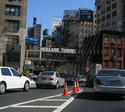Photographs of downtown skylines are often the "signature" of major metropolitan areas, as my former Amtrak Reform Council colleague and then Mayor of Milwaukee (later President and CEO of the Congress of New Urbanism) John Norquist has rightly said. The cluster of high rise office towers in the central business district (CBD) is often so spectacular – certainly compared with an edge city development or suburban strip center – as to give the impression of virtual dominance. I have often asked audiences to guess how much of a metropolitan area's employment is in the CBD. Answers of 50 percent to 80 percent are not unusual. read more »
New York
Where Inequality Is Worst In The United States
Perhaps no issue looms over American politics more than worsening inequality and the stunting of the road to upward mobility. However, inequality varies widely across America. read more »
No Fundamental Shift to Transit: Not Even a Shift
The American Public Transportation Association (APTA) is out with news of higher transit ridership. APTA President and CEO Michael Melaniphy characterizes the new figures as indicating "a fundamental shift going on in the way we move about our communities.” Others even characterized the results as indicating "shifting consumer preferences." The data shows either view to be an exaggeration.
1935 and 2013 read more »
High Tech Leaves NYC Behind
Is New York City ready to contest in high-tech against Silicon Valley? Fuggedaboutit.
Gotham is so far behind in every conceivable measurement — from engineering prowess to employment and venture funding — that even the idea is somewhat ludicrous.
While Madison Alley has marketed the city’s tech prowess before, going back to when owners of lower Manhattan real estate promoted “Silicon Alley,” the action has been elsewhere. read more »
- Login to post comments
Where New Yorkers are Moving
The American Community Survey has released domestic migration data that was collected over a five year period (2007 to 2011). There is newer domestic migration data available, such as is annually provided by the Census Bureau's population estimates program, but not in the detail that the latest data provides. read more »
The Evolving Urban Form: Greater New York Expands
The term “Greater New York” was applied, unofficially, to the 1898 consolidation that produced the present city of New York, which brought together the present five boroughs (counties). The term “Greater” did not stick, at least for the city. When consolidated, much of the city of New York was agricultural. As time went on, the term "Greater" came to apply to virtually any large city and its environs, not just New York and implied a metropolitan area or an urban area extending beyond city limits. read more »
Affordable Housing in Suburbia
Like many older suburbs in high priced regions, Long Island faces two great crises: a loss of younger residents and a lack of affordable housing for the local workforce, including those employed as nurses, teachers and other professionals. read more »
Are Special Service Districts a Boon or a Bane?
America’s cities have been under fiscal pressure for an extended period of time. To cope with this, and better manage assets, they’ve increasingly turned to various forms of special purpose districts or entities for service delivery. Traditional independent service districts such as sewer districts or transit districts were often designed to circumvent bonding limits or to deliver services regionally, so were larger in scale. These newer service districts are much smaller in scope. They consist of two basic components: read more »
The Revolt Against Urban Gentry
The imminent departure of New York’s Mayor Michael Bloomberg, and his replacement by leftist Bill DeBlasio, represents an urban uprising against the Bloombergian “luxury city” and the growing income inequality it represents. Bloomberg epitomized an approach that sought to cater to the rich—most prominently Wall Street—as a means to both finance development growth and collect enough shekels to pay for services needed by the poor. read more »
Biking New York City: The Handlebar Tour
In case it has been a while since you have ridden a bicycle around Manhattan, the Bronx, Brooklyn or Queens — as I have in recent weeks — here is a shortlist of some developments around New York City: midtown sidewalks are overflowing with tourists and too narrow for the pedestrian flow (especially around the many Elmos posing in Times Square); the South Bronx, while still very poor, has an emerging middle class; cruise ships dock in Red Hook, Brooklyn, on the same piers that were once the provenance of gangland; potholes and deteriorating asphalt are everywhere, despite Mayor Michael Blo read more »



















